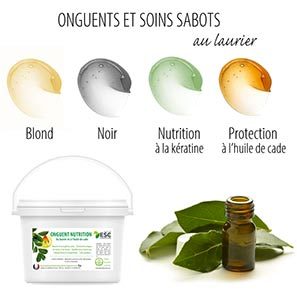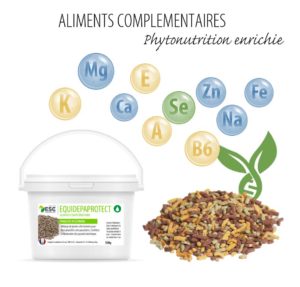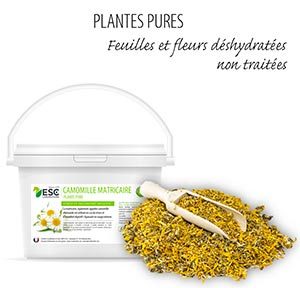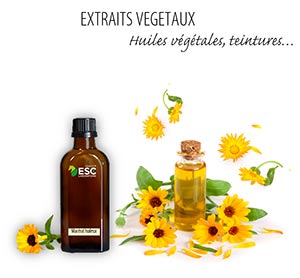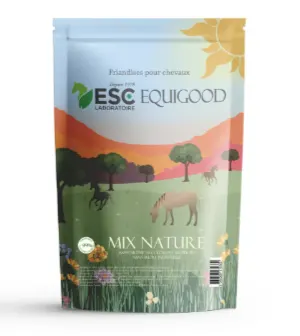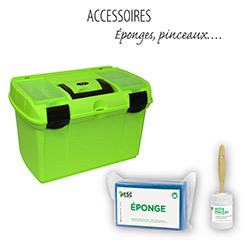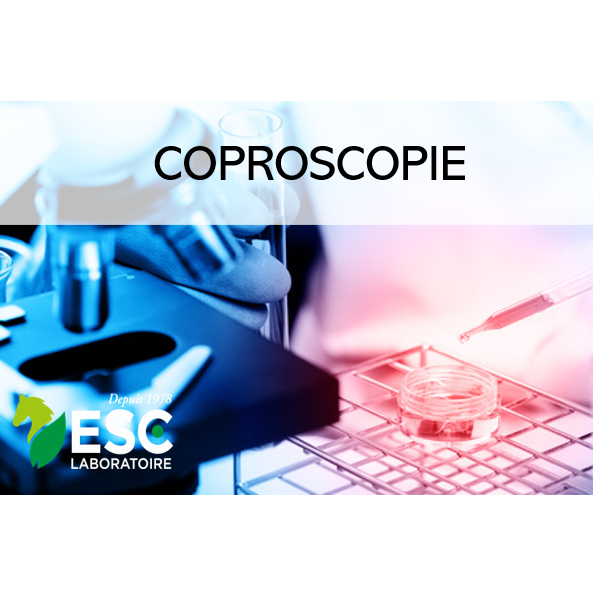CHEVAL COPROSCOPY – Complete sampling kit
37,50€ TTC
125,00€ /kg
14 in stock
The coproscopy in horses is an analysis of the crottins under microscope that allows to know the parasitic status of a horse and whether or not to defuse it. Complete kit facilitating sampling and sending of the sample. Analysis by our certified partner EUROFINS. Results communicated directly by our veterinarian.
Why perform a coproscopy in the horse?
The coproscopy in horses is an analysis of the crottins under microscope that allows to know at a given moment the parasitic status of a horse and whether or not to defuse it.
To perform its coproscopy, ESC Laboratoire selected as its partner EUROFINS, certified laboratory and European leader in laboratory analysis.
Coproscopic analysis is an integral part of the principle of Reasoned vermifugation which consists of using chemical deworming only when necessary. As a reminder, systematic vermifugation 3 to 4 times a year promotes the appearance in parasites of resistance to certain molecules, weakens microbiota intestinal animal and animal negative environmental impact.
The coproscopy in horses may be performed in a isolated individual or in the context of management of herd. It allows us to know which animals are the most host of parasites (it is considered that 80% of the parasites of a herd are housed in only 20% of the equidae called "forts excretors") and to put in place a suitable vermifugation protocol.
The Coproscopy In addition to the above advantages, therefore, it is possible to save on the medium and long term by limiting the number of treatments used.
What is coproscopy in horses?
The coproscopy in horses is a simple, fast and non-invasive method which consists of observing with a microscope on eggs a small grid. Coproscopic analysis is therefore qualitative and quantitative analysis.
It is as you have understood the eggs of parasites excreted in the crottins that are analysed and not the adult parasites or larvae.
Qualitative analysis : The presence of eggs of certain digestive parasites that should not be found in a healthy horse (such as tenia) is a indicator for deworming. This analysis also allows foradapt the molecule used.
Quantitative analysis : Counting eggs, expressed in number of eggs per gram of crottin or opggives an indication of the amount of adult parasites present in the body of the horse.
In the particular case of small strongles, threshold 200 opg has been defined, beyond which it is preferable to treat. As the pathogenicity of small strongles is low in a healthy horse, the aim is to limit infestation to a state acceptable to his health, without eliminating all parasites? This reduces the number of deworms used.
What is the sampling kit for coproscopy?
Once your order is placed on the site, you will receive in your package a complete sampling kit specially designed for facilitate collection and dispatch to the analytical laboratory Your horse's crottins.
The sampling kit for coproscopy is composed of:
– 1 information sheet with sampling method, to be completed before dispatch (do not forget your email address and if possible your phone number so that our veterinarian can contact you easily),
– 1 sterile sample vial (60ml) for the crottin sample,
– 1 Biohazard transport bag containing the vial,
– 1 bubble envelope containing the Biohazard bag and the completed information sheet,
– 1 good Chronopost 13h with envelope.
How to perform and send the sampling for coproscopy?
1 – Remove fresh crottin directly into the rectum of the animal or as soon as it has been made.
2 - Fill the sample vial up to a maximum of 1 cm from the upper edge (25 grams minimum),
3 – Close the vial and wipe thoroughly.
4 - Identify the vial with the number of the animal, as shown on the test request sheet.
5 - Place the vial in the Biohazard transport bag and seal it.
6 - Place the sealed bag in the bubble envelope with the completed document.
7 - Place the bubble envelope in the Chronopost envelope and go to the post office with the correct CHRONO 13 and prepaid envelope.
Once the sample of crottins received and analysed by our partner EUROFINS, the results of the coproscopy of your horse are sent directly to the veterinarian of ESC laboratory.
It is the latter who contacts you by email (and possibly by telephone as appropriate) to communicate these results and advise you.
Approximately 5 working days after receipt of the sample by EUROFINS to receive the results.
The advice of our veterinarian
– If possible, send the crottin sample on the same day, otherwise keep it fresh until 24 hours.
– In hot weather, add an ice bag for Chronopost shipping.
– Avoid sending the levy on Friday.
What digestive parasites are found in coproscopy?
The Coproscopy allows to observe the eggs of the majority of digestive parasites in horses Gastrointestinal strongles, oxyides, anoplocephals (tenias), coccidia, and strongyloids and parascaris (which are foal parasites).
When should a coproscopy be performed?
It is recommended that coproscopy in horses :
– In case of suspicion of parasitism,
– To replace blind vermifugation (although some recommend 1 to 2 systematic vermifugations per year, especially to lAutumn),
– To check the effectiveness of a vermifuge: in this case, perform a Control coproscopy 2-3 weeks after vermifugation,
– When a new individual arrives,
– In order to set up a reasoned vermifugation programme within a herd.
The frequency of coproscopys depends on several criteria:
– Clinical examination of the horse,
– Living conditions (the risk of parasitism is greater in the event of overgrazing and poor grazing management),
– Parasitic status (low or strong excretor).
Generally, in a healthy animal living in good conditions, 3 coproscopy is performed in the first year and 2 in the following years.
What are the limits of coproscopy in horses?
The coproscopy in horses has certain limitations:
– It is not possible to differentiate eggs from small strongles (also called cyatostoms) from large stongle eggs. This requires a very thorough analysis. It is now considered that the vast majority of the strongle eggs found during the Coproscopy are eggs of small strongles, since the major strongles have been largely eradicated by the excessive vermifugation programmes of recent decades.
– The worms are less active during cold season, especially the small strongles that can s-enkyster in the intestinal mucosa (called hypobiosis). It is therefore possible to have false negatives during this period.
– Some believe that some worms such as tenia excrete their eggs intermittently. This theory now seems to be in question.
– It is difficult to isolate deoxyur eggs in crottins, with females laying mostly at the margins of the anus (these parasites are responsible for itching in this region). Only a scotch test can isolate them in case of negative results.
– Some worms such as gastrophils are not isolated at the Coproscopy.
When and with what to defuse your horse?
You can't make that decision on your own. This is why the Veterinarian of ESC laboratory will contact you by mail (and possibly by telephone) to communicate to you the results of coproscopy of your horse and you Counsellor, especially if there is a need to contact your veterinarian.
In fact, the final decision whether to defuse or not belongs to your veterinary treatment. The latter knows the various digestive parasites of the horse and will take into account, in addition to the results of the Coproscopy, different criteria for deciding on a possible vermifugation: clinical condition of your horse (weakening, prickly hair, possible colic, etc.), living conditions (especially if there is a possible overgrazing), herd management ...
Don't forget that a chemical deworming is a medicine by prescription (for the vast majority of demifuges).
After vermifiguration, it is recommended to collect the crottins for 3 to 5 days, at the risk of contaminate the pastures.
Once your order is placed on the site, you will receive in your package a complete sampling kit specially designed for facilitate collection and dispatch to the analytical laboratory Your horse's crottins.
The sampling kit for coproscopy is composed of:
– 1 information sheet with sampling method, to be completed before sending (don't forget your email address and if possible your phone number so that our veterinarian can contact you easily),
– 1 sterile sample vial (60ml) for the crottin sample,
– 1 Biohazard transport bag containing the vial,
– 1 bubble envelope containing the Biohazard bag and the completed information sheet,
– 1 good Chronopost 13h with envelope.
1 – Remove fresh crottin directly into the rectum of the animal or as soon as it has been made.
2 - Fill the sample vial up to a maximum of 1 cm from the upper edge (25 grams minimum),
3 – Close the vial and wipe thoroughly.
4 - Identify the vial with the number of the animal, as shown on the test request sheet.
5 - Place the vial in the Biohazard transport bag and seal it.
6 - Place the sealed bag in the bubble envelope with the completed document.
7 - Place the bubble envelope in the Chronopost envelope and go to the post office with the correct CHRONO 13 and prepaid envelope.
The advice of our veterinarian
– If possible, send the sample on the same day, otherwise keep it fresh until 24 hours.
– In hot weather, add an ice bag for Chronopost shipping.
– Avoid sending the levy on Friday.
In order to carry out its coproscopy, ESC Laboratoire has selected as its partner EUROFINS, certified laboratory and European leader in laboratory analysis.
Once the analysis is done by EUROFINS, the results of your horse's coproscopy are sent directly to the laboratory ESC veterinarian.
It is the latter who contacts you by email (possibly by telephone) to communicate these results and advise you.
Count about 5 working days after receipt by EUROFINS of the crottins of your horse to receive the results.



